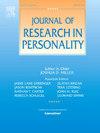结合英语、荷兰语和波兰语的人格类型名词的核心结构,并对斯瓦希里语的类型名词结构进行了关键测试
IF 2.6
2区 心理学
Q2 PSYCHOLOGY, SOCIAL
引用次数: 0
摘要
我们比较了三种基于类型名词的特征结构,找出它们共同的核心结构。我们使用了607名参与者对372个英语类型名词、800名参与者对571个荷兰语类型名词和1325名参与者对454个波兰语类型名词的评分。使用同余系数比较基于PCA的因子结构。SCA应用于类型名词的联合矩阵,共有2737名参与者对所有三种语言共享的331个类型名词进行了评分。由此产生的结构反映了五巨头的版本,但也缩小到了他们的演讲角色。最后,将结果与斯瓦希里语中基于类型名词的结构进行了比较。本文章由计算机程序翻译,如有差异,请以英文原文为准。
Kernel structure of the combined English, Dutch, and Polish personality type-nouns, with a critical test against a type-noun based structure in Swahili
We compared three trait-structures based on type-nouns, to find their common kernel structure. We used ratings from 607 participants on 372 English type-nouns, 800 participants on 571 Dutch type-nouns, and 1,325 participants on 454 Polish typenouns. PCA based factor structures were compared using congruence coefficients. SCA was applied on a joint matrix of type-nouns with ratings from a total of 2,737 participants on 331 type-nouns shared by all three languages. The resulting structure reflected versions of the Big Five, yet narrowed to their oratory role. Finally, the results were compared with a type-nouns based structure in Swahili.
求助全文
通过发布文献求助,成功后即可免费获取论文全文。
去求助
来源期刊

Journal of Research in Personality
PSYCHOLOGY, SOCIAL-
CiteScore
5.40
自引率
6.10%
发文量
102
审稿时长
67 days
期刊介绍:
Emphasizing experimental and descriptive research, the Journal of Research in Personality presents articles that examine important issues in the field of personality and in related fields basic to the understanding of personality. The subject matter includes treatments of genetic, physiological, motivational, learning, perceptual, cognitive, and social processes of both normal and abnormal kinds in human and animal subjects. Features: • Papers that present integrated sets of studies that address significant theoretical issues relating to personality. • Theoretical papers and critical reviews of current experimental and methodological interest. • Single, well-designed studies of an innovative nature. • Brief reports, including replication or null result studies of previously reported findings, or a well-designed studies addressing questions of limited scope.
 求助内容:
求助内容: 应助结果提醒方式:
应助结果提醒方式:


